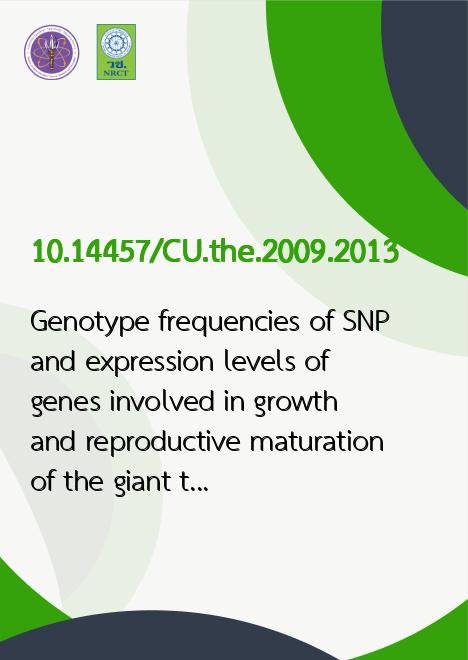
|
Genotype frequencies of SNP and expression levels of genes involved in growth and reproductive maturation of the giant tiger shrimp Penaeus monodon |
|---|---|
| รหัสดีโอไอ | |
| Title | Genotype frequencies of SNP and expression levels of genes involved in growth and reproductive maturation of the giant tiger shrimp Penaeus monodon |
| Creator | Sayan Prakobpetch |
| Contributor | Piamsak Menasveta, Bavornlak Khamnamtong |
| Publisher | Chulalongkorn University |
| Publication Year | 2552 |
| Keyword | Genes, Genomes, Penaeus monodon -- Growth, Gene expression |
| Abstract | The information on association between genotypic and phenotypic variations in the giant tiger shrimp (Penaeus monodon) is limited at present. Analysis of gene-based single nucleotide polymorphism (SNP) is one of the efficient approaches for discovery of genes significantly contributed in commercially important traits of this species. To identify SNP in the 5_ untranslated region (5_UTR) of nuclear autoantigenic sperm protein (NASP) and NADP-dependent leukotriene B4 12- hydroxydehydrogenase (LTB4DH), genome walking analysis was carried out and successfully identified their 5_UTR of 640 and 767 bp in length, respectively. Sequence-specific primers were designed and the amplified 429 and 592 bp fragments of respective genes were generated. SNP in NASP and LTB4DH of 14-month-old shrimp (N = 66) was examined by PCR-SSCP. NASP was monomorphic whereas 2 polymorphic SSCP genotypes (A and B found in 37 and 29 individuals, respectively) of LTB4DH were observed. In addition, polymorphism in dolichyl diphosphooligosaccharyl protein glycotransferase (DDPG, 376 bp), thyroid hormone binding protein (THBP, 595 bp), epidermal growth factor (EGF, 240 bp) and insulin degrading enzyme (IDE, 203 bp) gene segments was also examined in domesticated 3-month-old juveniles. The amplified product of DDPG and IDE was monomorphic (N = 110 for each gene). In contrast, 2 SSCP genotypes of EGF (A and B found in 266 and 74 individuals, respectively) and 4 SSCP genotypes of THBP (A, B, C and D found in 113, 4, 89 and 134 individuals, respectively) were observed. DNA sequencing of different SSCP genotypes of these genes was carried out. Seven SNPs and 3 indels were found between genotypes A and B of LTB4DH. In addition, eight SNPs positions (A vector T[subscript 80] , T vector C[subscript 137] , G vector A[subscript 149] , A vector G[subscript 306] , A vector G[subscript 312] , T vector C[subscript 382] , A vector G[subscript 422] and A vector G[subscript 494]) were found between four genotypes of THBP and two SNPs positions (A vector C[subscript 32] and C vector A[subscript 75]) were found among genotypes A and B of EGF. Association between SNP through SSCP genotypes of LTB4DH and the Gonadosomatic index (GSI) of 14-month-old P. monodon was not significant (P > 0.05). In contrast, a significant difference between frequencies of different SSCP genotypes and the body weight of 3-month-old P. monodon (N = 340) was observed in THBP (P < 0.05) but not in EGF (P > 0.05). Quantitative real-time PCR of NASP and LTB4DH in ovaries of broodstock and IDE, EGF and THBP in hepatopancreas of juvenile P. monodon was examined. The expression levels of NASP in ovaries of 14-month-old shrimp exhibiting different GSI values were not significantly different (P > 0.05). In contrast, LTB4DH in ovaries of group II (GSI = 0.5 – 1.0%, N = 12) was significantly greater than that of group I (GSI < 0.5%, N = 6; P < 0.05) but not different from that of group III (GSI > 1.0%, N = 12; P > 0.05) broodstock. However, the expression levels of ovarian LTB4DH in shrimp exhibiting SSCP genotypes A and B were not significantly different (P > 0.05). The expression levels of IDE, EGF and THBP in hepatopancreas of 3-month-old shrimp exhibiting fast (large, N = 22) and slow (small, N = 22) growth rates were not significantly different (P > 0.05). Likewise, the expression levels of these genes in hepatopancreas of juveniles exhibiting different SSCP genotypes were also not significantly different (P > 0.05). |
| URL Website | cuir.car.chula.ac.th |